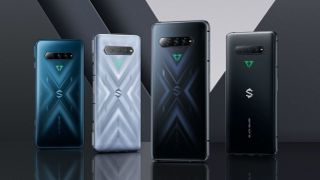Xiaomi Black Shark 4 and 4 Pro release date, price, specs and features
Xiaomi's new gaming phones

The Xiaomi Black Shark 4 is likely going to end up as the most affordable gaming smartphone of 2021, as its price has been revealed and the phone seems surprisingly cheap.
The Black Shark 4 is the Xiaomi sub-brand's fourth-generation gaming smartphone, and along with a Black Shark 4 Pro it's Mi's newest assault on the busy niche of handsets dedicated to mobile gaming.
Launched in China in March 2021, these two new phones rival contemporaries like the Nubia Red Magic 6 and Asus ROG Phone 5. While the Black Shark 4 Pro tries to rival them on sheer specs and power, the 'vanilla' phone doesn't.
We'll run you through both phones below, so you can see what they're like and how they compare.
Cut to the chase
- What is it? Xiaomi's fourth-generation gaming phones
- When is it out? It was released May 3
- How much will it cost? Starting at $499 / £429 (roughly AU$899)
Xiaomi Black Shark 4 release date and price

The Xiaomi Black Shark 4 went on sale May 3 - the Pro model didn't, though, and we're still waiting to hear when that'll launch and how much it'll cost.
We have the 'vanilla' Black Shark 4's price though, and you can see the costs below. We've got the US and UK costs, and the Australian costs are a conversion.
| Configuration | US price | UK price | AU price |
| 8GB RAM, 128GB storage | $499 | £429 | $899 |
| 12GB RAM, 256GB storage | $599 | £519 | Not on sale |
At that price this is the cheapest gaming phone launched in 2021 - so far, at least - which could make it beat out the competition.
Get daily insight, inspiration and deals in your inbox
Sign up for breaking news, reviews, opinion, top tech deals, and more.
Design and display

The Black Shark 4 phones both drop the bezel that most gaming phones have, and instead house their front-facing cameras in punch-hole cut-outs at the top of the display, which means a small chunk of the display is missing.
The phones have less-dynamic rear designs than their predecessors, but some people may like that - it seems only the Pro model has LEDs on the back.
To the edges of the phone, there's a side-mounted fingerprint scanner. Both handsets also have physical triggers, which are normally flush in the phone, but pop out when you activate them.
Do these phones have IP ratings? We don't know. They do have 3.5mm headphone jacks and NFC though.
In terms of display, both handsets tout 6.67-inch FHD+ AMOLED screens with 144Hz refresh rates and super-speedy 720Hz touch input rates. This latter spec should make them great for gaming, as it makes sure your touch is registered quickly.
Cameras and battery

The Black Shark 4 and 4 Pro both have three rear cameras, and they have two in common too - that's an 8MP and 5MP sensor (though we don't know what lens they're paired with).
The Black Shark 4 also has a 48MP main camera, whereas the 4 Pro rocks that up to 64MP. We don't know the selfie camera resolution on either phone.
Both phones match when it comes to battery size and charging speeds. They have 4,500mAh power packs, and charge up at a super-speedy 120W.
Performance and specs

As previously mentioned, the Black Shark 4 phones have varying amounts of RAM, from 6GB in the 'vanilla' model to 16GB in the Pro, and there's some variation in storage space too.
The Black Shark 4 has the Snapdragon 870 chipset, while the 4 Pro has the top-end Qualcomm Snapdragon 888. It's curious to see a gaming phone without the best chipset available to it, though the 870 is pretty good, and it seems Xiaomi tried to make this an affordable gaming phone.
Most gaming phones have gaming-dedicated modes, which mutes notification and calls and dedicates all a phone's power to the game at hand, and Xiaomi has Shark Space.
In this generation of phones, it seems Shark Space has some changes - there's more to it than just a list of games to boot up, and in the launch event, an AI companion from popular game Genshin Impact popped up and started talking too.
To make the phones good for gaming, Black Shark detailed the numerous antennae on the phone, so you don't risk blocking signal with your hands when gaming. Both devices are 5G-ready.
- What we expect from the iPhone 13

Tom Bedford was deputy phones editor on TechRadar until late 2022, having worked his way up from staff writer. Though he specialized in phones and tablets, he also took on other tech like electric scooters, smartwatches, fitness, mobile gaming and more. He is based in London, UK and now works for the entertainment site What To Watch.
He graduated in American Literature and Creative Writing from the University of East Anglia. Prior to working on TechRadar, he freelanced in tech, gaming and entertainment, and also spent many years working as a mixologist.
Most Popular

